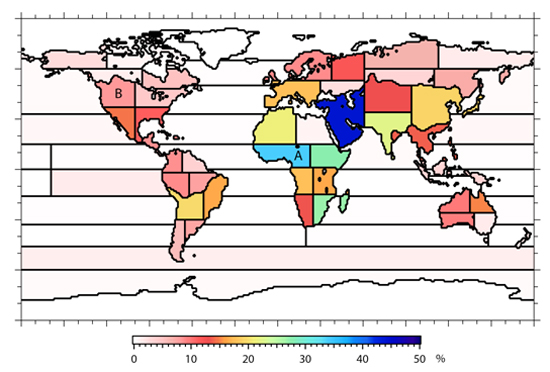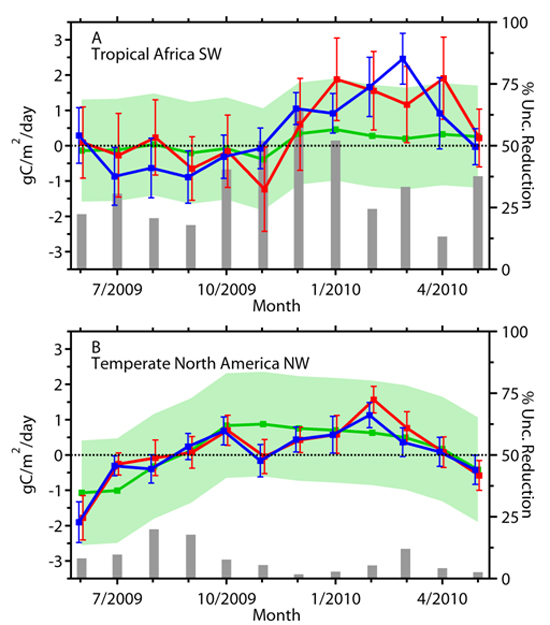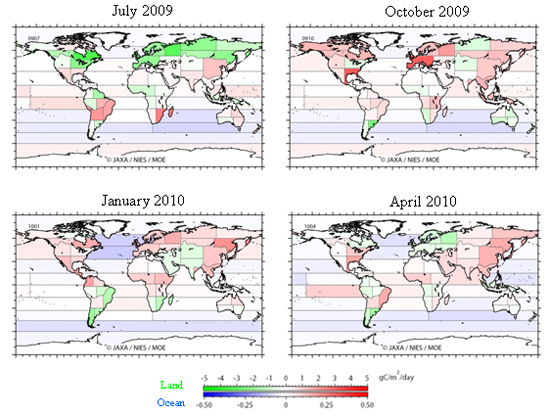
On Estimating Global Monthly Carbon Dioxide Fluxes by Region, utilizing the observational data obtained by the Greenhouse gases Observing SATellite “IBUKI”(GOSAT)
Ministry of the Environment, Japan (MOE)
Japan Aerospace Exploration Agency (JAXA)
Tatsuya Yokota, Head, Satellite Remote Sensing Section
Center for Global Environmental Research (CGER), NIES
(+81-29-850-2550)
Shamil Maksyutov, Head, Biogeochemical Cycle Modeling
and Analysis Section, Center for Global Environmental Research (CGER), NIES
(+81-29-850-2212)
Yutaka Matsuzawa, Director, Office for Global Environment Research, MOE
(+81-3-3581-3351: ext. 6730),
Midori Sasaki, Deputy Director (ext. 6731),
Taro Kawasato, Chief (ext. 6735)
Public Affairs, Press Group, JAXA (+81-50-3362-4374)
The Ministry of the Environment Japan, the National Institute for Environmental Studies, and the Japan Aerospace Exploration Agency jointly conduct the GOSAT Project. GOSAT itself was launched on January 23, 2009.
Using observational data from GOSAT and ground-based data, the estimation of monthly regional CO2 sources and sinks (net fluxes) and their uncertainty was carried out. It was demonstrated that the CO2 concentration data retrieved from GOSAT soundings can reduce the uncertainty of fluxes estimated from ground-based data alone.
The outcomes of this research were published in the Meteorological Society of Japan’s Scientific Online Letters on the Atmosphere (SOLA) on October 29, 2011. These estimations will now be disseminated to affiliated researchers selected by means of GOSAT Research Announcements. Following the assessment and validation of these results by the researchers, the improved flux data will be made available to the general public.
1. Summary of the achievement
(1) Improved precision of CO2 source/sink (flux) estimates
Monthly CO2 sources and sinks (net fluxes) in 64 subcontinental-scale regions over a 12 month period from June 2009 to May 2010 were estimated using both CO2 concentrations retrieved from the soundings of the Greenhouse gases Observing SATellite “IBUKI” (GOSAT) and the published ground-based CO2 values (Note 1). It has been confirmed that uncertainties in CO2 flux estimates can be reduced significantly (as much as by about 50%) with the addition of the GOSAT data to the ground-based monitoring data (refer to the attached document for more detail). This constitutes the first concrete demonstration of the utility of satellite data in estimating global CO2 fluxes. This result was published as a scientific paper in the Scientific Online Letters on the Atmosphere (SOLA) issued by the Meteorological Society of Japan on October 29, 2011.
(2) Contribution of the CO2 flux estimation with GOSAT data
ⅰ) With the addition of the GOSAT observational data to the ground-based monitoring data, significant uncertainty reduction was achieved in the monthly regional CO2 flux estimates. It is expected that continuous CO2 monitoring by GOSAT and further refinement of the data processing methods will lead to effective monitoring of variations in monthly regional CO2 fluxes.
ⅱ) In particular, uncertainties of CO2 fluxes estimated for South America, Africa, the Near and Middle East, and Asia have been reduced by as much as about 50% (annual average) with the addition of the GOSAT data to the ground-based monitoring data.
ⅲ) The seasonal trends of summertime CO2 uptake associated with plant photosynthesis and wintertime CO2 emission in high latitudinal regions of the northern hemisphere are broadly consistent with past findings. It is expected that the response of terrestrial biosphere to future climate change, in terms of changes in flux amounts, may be detected in its early stage with continuing observation by GOSAT and further refinements in the data processing methods.
ⅳ) The global annual flux for the period of June 2009 to May 2010 was evaluated at around 4 gigatons of carbon per year, which is almost equivalent to the values calculated from the growth rates of CO2 concentrations in the atmosphere for this period. The validity of this annual flux and the contributions of anthropogenic emissions or fluxes of natural origin will be the subject of further investigations.
ⅴ) Monthly fluxes calculated from the GOSAT data and the ground-based monitoring data in some regions show differences to those calculated from only the ground-based monitoring data. It is expected that continuous monitoring by GOSAT and further research undertakings will yield further understanding of the CO2 flux behavior.
2. Next steps
(1) Evaluation and verification of the results of CO2 flux estimation by overseas research
institutes and researchers in the carbon cycle research field.
The 64-regional monthly flux estimates will be disseminated to affiliated researchers selected by means of GOSAT Research Announcements for Principal Investigators, in order for these estimates to be evaluated and verified. In addition we will evaluate the accuracy and consistency of the results by means of comparisons with independent flux estimation results from overseas research groups. At the same time, suggestions from researchers worldwide engaged in this field will be collected by means of international workshops and meetings. On the basis of these results, we intend to make improvements as they prove necessary, and thereafter the monthly regional CO2 fluxes will be recalculated (Note 3). With this improved CO2 flux data product, the product of the three-dimensional distributions of CO2 concentration (Note 4) will be prepared and released to the general public.
(2) Ongoing development of the GOSAT follow-on
With this first demonstration of the utility of the GOSAT data, we seek to expand the contribution of GOSAT to carbon cycle research, global environmental monitoring, and climate change policy making. The MOE, NIES and JAXA have begun investigations aimed at the development of a GOSAT follow-on – one with enhanced capacities for efficient measurements. A launch date has been set for around 2016 at the earliest.
The GOSAT follow-on would carry an advanced Fourier Transform Spectrometer in order to increase the number of measurements. Furthermore, improvements will be made in the data processing algorithms and flux estimation models in order to obtain more precise flux estimates.
With the planned launch of a satellite Orbital Carbon Observatory 2 (OCO-2) by the United States in the near future, we intend to continue to collaborate and cooperate internationally with these communities on the measurement of greenhouse gases from space.
[Contact Information]
Data analysis results, and GOSAT data:
Dr. Tatsuya Yokota, Head, Satellite Remote Sensing Research Section, CGER, NIES /
NIES GOSAT Project Leader
Phone: +81-29-850-2550
Dr. Shamil Maksyutov, Head, Biogeochemical Cycle Modeling and Analysis Section,
CGER, NIES / NIES GOSAT Project Sub-Leader
Phone: +81-29-850-2212
GOSAT, onboard sensors, and observation status:
Mr. Masakatsu Nakajima
Satellite Applications and Promotion Center,
Space Applications Mission Directorate, JAXA/ GOSAT Mission Manager,
Phone:+81-50-3362-6130
-
(Note 1) Published global CO2 data from NOAA/ESRL/GMD as GLOBALVIEW-CO2 2011.
Expressed as “GV data” in the attached document.
-
Ref. http://www.esrl.noaa.gov/gmd/ccgg/globalview/co2/co2_intro.html
-
(Note 2) Online journal of Scientific Online Letters on the Atmosphere (SOLA) issued by the Meteorological Society of Japan
Title of the paper: On the benefit of GOSAT observations to the estimation of regional CO2 fluxes
Authors: H. Takagi, T. Saeki, T. Oda, M. Saito, V. Valsala, D. Belikov, R. Saito, Y. Yoshida, I. Morino, O. Uchino, R. J. Andres, T. Yokota, and S. Maksyutov
Bibliography: SOLA, 2011, Vol. 7, 161-164, doi:10.2151/sola.2011-041 - (Note 3) This will be released as the Level 4A product of the GOSAT standard data products.
- (Note 4) This will be released as the Level 4B product, 3D distribution of CO2 concentration at intervals of 6 hours in every 2.5 degree mesh, of the GOSAT standard data products.
Appendix
On the estimation of regional CO2 fluxes from GOSAT observations
The GOSAT Project, a joint undertaking of the Ministry of the Environment Japan, the National Institute for Environmental Studies, and the Japan Aerospace Exploration Agency, has been providing the general public with the global distribution of CO2 concentrations (column-averaged dry air mole fractions of CO2, or XCO2) retrieved from GOSAT data obtained over clear-sky regions.
Researchers of the Project estimated regional CO2 fluxes from data collected in the networks of surface CO2 measurement sites and the GOSAT XCO2 retrievals via inverse modeling. Until recently, regional CO2 fluxes have been inferred from the ground-based network data (about 200 sites around the globe). Since many of the measurement sites are located over the developed nations, the uncertainty of fluxes estimated for regions away from the observation networks was sizable. This time, the researchers evaluated the degree to which the GOSAT XCO2 retrievals contribute to reducing the uncertainty of the regional fluxes. Their findings appeared in the Scientific Online Letters on the Atmosphere, a publication by the Meteorological Society of Japan, on October 29, 2011 (available at http://www.jstage.jst.go.jp/article/sola/7/0/161/_pdf). The results are outlined below.
1. Method
The CO2 fluxes were estimated for 64 subcontinental-scale regions on a monthly basis over a one-year period between June 2009 and May 2010 from
- ground-based network data (GLOBALVIEW-CO21; hereafter denoted as GV)
- both the GV data and GOSAT XCO2 retrievals.
In the analysis, the rate of uncertainty reduction (UR) in percent attained via adding GOSAT XCO2 retrievals to GV data was calculated as

where σGV and σGV+GOSAT denote the uncertainty of a monthly flux estimated from GV data only and from both GV dataset and GOSAT XCO2 retrievals, respectively.
2. Results
Figure 1 shows annual means of the regional uncertainty reduction rates. Pronounced reductions, as much as about 50%, were found in the uncertainty of fluxes estimated for regions in South America, Africa, Middle East, and Asia, where the sparsity of the ground-based measurement sites is most evident.

Shown in Figure 2 is the time series of the monthly uncertainty reduction rate and fluxes estimated from GV data and from both GV data and GOSAT XCO2 retrievals. Two regions, south-western tropical Africa (marked as A in Fig. 1; top panel in Fig. 2) and north-western temperate North America (B in Fig. 1; bottom panel in Fig. 2), are contrasted here. South-western tropical Africa and north-western temperate North America represent regions where ground-based measurement sites are sparse and dense, respectively. The lines in the figure show fluxes estimated from GV data (red) and from both GV data and GOSAT XCO2 retrievals (blue). The vertical bars (gray) indicate the monthly uncertainty reduction rate. The uncertainty associated with the estimated fluxes is shown with error bars. The green line and the shade behind indicate the value of a priori flux and its uncertainty used in inverse modeling. The GV-based monthly fluxes estimated for south-western tropical Africa (red) are associated with large uncertainty since the estimation of the fluxes is based on measurements taken distant from the region. By introducing GOSAT XCO2 retrievals to GV data, the uncertainty of the fluxes was reduced significantly (blue error bar). In contrast, a relatively large number of ground-based measurement sites are located within and nearby north-western temperate North America. In addition, the data obtained at these sites are higher in precision than GOSAT XCO2 retrievals. Therefore, they have larger influence in determining the region's flux. Because of this, the fluxes and their uncertainty estimated from GV data and from both GV data and GOSAT XCO2 retrievals are nearly identical over the analysis period. GOSAT XCO2 retrievals are particularly beneficial in reducing the uncertainty of fluxes estimated for regions in Africa, South America, Middle East, and Asia.

The 64-regional fluxes estimated from GV data and GOSAT XCO2 retrievals are shown in Figure 3. The results for summer (July 2009), fall (October 2009), winter (January 2010) and spring (April 2010) are presented. Seasonal trends seen in the fluxes of high latitudinal regions in the Northern Hemisphere are broadly consistent with past findings.

3. Plans
For evaluation purposes, the GV-GOSAT based flux data described above are released on October 28th to researchers in the field of carbon balance estimation and atmospheric transport modeling whose research proposals were adopted during the past GOSAT Research Announcements. It is also planned that these flux estimations are intercompared with those obtained at several other research institutes overseas for data quality check. The result of these evaluation studies will be reflected in improving the data processing algorithms. The release of the 64-regional fluxes (the Level 4A data product) and the three-dimensional CO2 distributions (the Level 4B data product) simulated with the 64-regional fluxes to the general public follows after the completion of these data evaluation and improvement processes. The temporal coverage of these data products will be extended after an annual update of GV data.
The Ministry of the Environment Japan, the National Institute for Environmental Studies, and the Japan Aerospace Exploration Agency will continue with the cooperative effort in providing the general public with the GOSAT data products. The three parties recently initiated the preparation of developing a GOSAT follow-on.
References
- GLOBALVIEW-CO2 (2011), Cooperative Atmospheric Data Integration Project - Carbon Dioxide. CD-ROM, NOAA ESRL, Boulder, Colorado (Also available on Internet via anonymous FTP to ftp.cmdl.noaa.gov, Path: ccg/co2/GLOBALVIEW).
- Morino, I., Uchino, O., Inoue, M., Yoshida, Y., Yokota, T., Wennberg, P. O., Toon, G. C., Wunch, D., Roehl, C. M., Notholt, J., Warneke, T., Messerschmidt, J., Griffith, D. W. T., Deutscher, N. M., Sherlock, V., Connor, B., Robinson, J., Sussmann, R., and Rettinger, M. (2011), Preliminary validation of column-averaged volume mixing ratios of carbon dioxide and methane retrieved from GOSAT short-wavelength infrared spectra, Atmos. Meas. Tech., 4, 1061-1076, doi:10.5194/amt-4-1061-2011.
- What's New
- What's New 2025
- What's New 2024
- What's New 2023
- What's New 2022
- What's New 2021
- What's New 2020
- What's New 2019
- What's New 2018
- What's New 2017
- What's New 2016
- What's New 2015
- What's New 2014
- What's New 2013
- What's New 2012
- What's New 2011
- What's New 2010
- What's New 2009
- What's New 2008
- What's New 2007
- What's New 2006
- What's New 2005
- What's New 2004
- What's New 2003
- What's New 2002
- Event Information
- Visit NIES